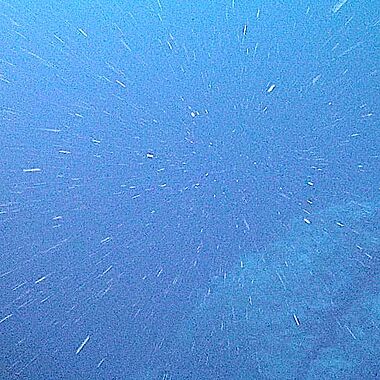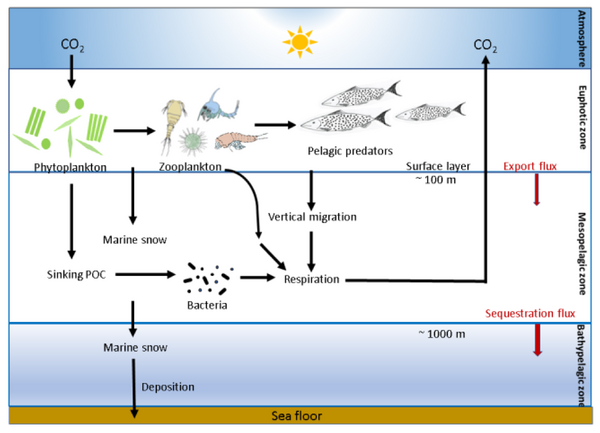Marine snow facts for kids
Marine snow, sometimes called "ocean dandruff, is not actually snow, but a continuous shower of tiny bits of natural material falling from the sunny top layers of the ocean down to the dark depths below.
This process is very important. It carries energy and food from the surface, where there is a lot of life, down to the creatures living in the deep, dark parts of the ocean. This is part of a process scientists call the biological pump, which helps move nutrients and carbon around the ocean.
The name "marine snow" was created by the explorer William Beebe in the 1930s when he saw it from his deep-sea submarine, the bathysphere. Because marine snow is a vital food source, it supports entire ecosystems in the deep sea where sunlight can't reach.
Contents
What Is Marine Snow Made Of?
Marine snow is a mix of many different things, most of which are organic (meaning they come from living things). These include:
- Dead or dying tiny plants (phytoplankton) and animals (zooplankton)
- Shells and skeletons from small sea creatures
- Animal waste (poop)
- Sand, soot, and other dust that has been blown into the ocean
All these little bits get sticky and clump together, forming flakes called "aggregates." Some types of bacteria and plankton release a slimy substance that helps everything stick together. These flakes can grow to be several centimeters wide. It can take weeks for them to sink all the way to the ocean floor.
A Floating Buffet
As the flakes of marine snow sink, they become a traveling buffet for many ocean animals. Microbes, zooplankton, and other filter-feeders eat the snow as it falls. Most of it gets eaten in the top 1,000 meters of the ocean.
For creatures in the deep sea, where there is no sunlight to help plants grow, marine snow is their main source of food. It is the foundation of the entire deep-sea ecosystem. The small amount of snow that doesn't get eaten settles on the ocean floor, forming a soft, muddy layer called ooze.
How Flakes Form and Sink
The journey of marine snow is all about clumping together and sinking. The process starts with tiny particles, too small for most animals to eat. For these particles to become food, they need to clump together into larger flakes.
The Ballast Effect
Some flakes mix with heavier materials, like tiny grains of sand or minerals from dust. This extra weight acts like a ballast on a ship, making the flake sink much faster.
A faster sink rate is important. It means the flake has a better chance of reaching the deep ocean before it is completely eaten. This helps carry carbon to the seafloor more efficiently.
Breaking Apart
The journey isn't always smooth. When animals like zooplankton graze on the large flakes of marine snow, they can break them up into smaller pieces. This process is called fragmentation.
A World of Life on a Flake
A single flake of marine snow is not just a clump of dead stuff; it's a thriving, tiny ecosystem. Each flake is covered with millions of microbes, especially bacteria. The number of bacteria on a flake can be a thousand times higher than in the water around it.
These tiny organisms are incredibly important. They break down the material in the marine snow, releasing nutrients back into the water. This recycling process is a key part of the ocean's food web.
As shown in the diagram, marine snow is a key part of the biological pump. Here's how it works:
- Tiny plants called phytoplankton at the surface use sunlight to turn carbon dioxide into food, just like plants on land.
- When these plants and the animals that eat them die, they become part of marine snow.
- The snow sinks, carrying that carbon down into the deep ocean.
- Much of this carbon is eaten and released by deep-sea creatures, but some of it reaches the ocean floor.
This process "pumps" carbon from the surface to the deep sea, where it can be stored for a very long time. Only about 1% of the material from the surface makes it all the way to the seafloor.
Why Marine Snow Matters for Our Planet
Marine snow might seem like just ocean dust, but it plays a huge role in the health of our planet.
Storing Carbon
The biological pump powered by marine snow is one of Earth's most important systems for controlling climate. When carbon is carried into the deep ocean, it can stay there for more than 1,000 years, locked away from the atmosphere. This helps keep the planet from getting too warm.
Scientists are even studying if we can encourage this process to help fight climate change by removing more carbon dioxide from the air.
Effects of a Warming Ocean
Climate change could affect marine snow. As the ocean's surface gets warmer, it may not mix as well with the cold, nutrient-rich water from below. This is called stratification.
With fewer nutrients at the surface, phytoplankton can't grow as well. This could lead to less primary production, which means less marine snow. A decrease in marine snow would weaken the biological pump and its ability to store carbon.
Discovering New Life
The tiny microbes that live on marine snow are also fascinating to scientists. As the snow falls, it can carry bacteria from the surface to the very bottom of the ocean. This means bacteria in different parts of the ocean might be able to share genes.
By studying these microbes, scientists might discover new species that can survive in extreme cold and under high pressure. These discoveries could lead to new medicines or be useful in technology and bioengineering.
See also
- Biological pump
- Detritivore
- Diffusion-limited aggregation
- f-ratio
- Martin curve
- Particulate organic matter
- Sea snot
- Sediment trap
- Whale fall
- Vampire squid
- Seston



